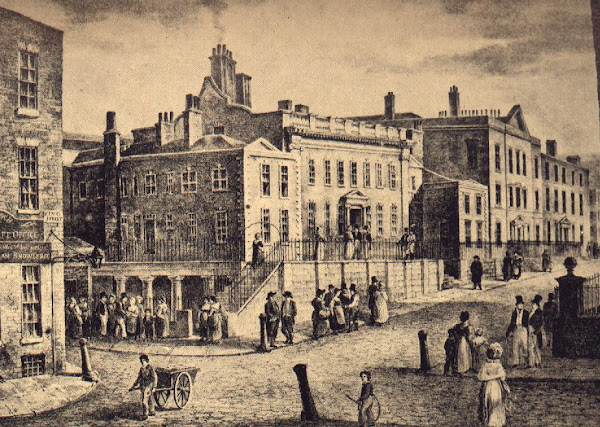




The name of Dick Turpin is firmly embedded in the British national consciousness, often bracketed together with Robin Hood as heroes who operated outside the law, but who practised a proto-socialist redistributive justice: robbing the rich to give to the poor.
The historian James Sharpe tells the full story in his book, with the self explanatory title Dick Turpin: The Myth of the English Highwayman (London, Profile, 2004). Full credit is given to Ainsworth as creator of the myth, as follows:
'In Rookwood Ainsworth not only created a fictionalised image of Dick Turpin, but also re-created the highwayman as an heroic figure, a gentleman of the road, courageous, brave, an embodiment of English virtues as perceived in the 1830s, an entity whose passing was to be regretted. Our idea of Turpin as a romantic hero, and our broader romantic notions about highwaymen, owe almost everything to Rookwood ... Ainsworth’s greatest literary creation lives on. Dick Turpin, the man whom Ainsworth did so much to reinvent, and whose character he so thoroughly refurbished, remains as familiar and as celebrated as ever. If for nothing else, Ainsworth deserves his place in the cultural history of England for inventing one of those very few historical figures whom all of us recognise. For it is essentially Ainsworth’s Turpin that we remember and celebrate today, not the pock-marked man who swung from the ‘Three-Legged Mare’ at York in 1739.'
Anyone interested in Turpin, highwaymen and/or Ainsworth should grab a copy of this superb book without delay.
A measure of the enduring quality of the Turpin myth is the extent to which it has been absorbed into popular culture. Sharpe covers all this in some detail, including the ‘70s TV series starring Richard O’Sullivan, and unforgettably, Carry on Dick, which featured Sid James (who else?) as the highwayman, who appears in the guise of the Reverend Flasher, in the village of Upper Denture, near York. Barbara Windsor is his sidekick and fellow highwayperson, and Kenneth Williams a Bow Street runner (Captain Desmond Fancy), etc, etc. Great stuff, which illustrates how far the myth can be stretched. Similarly, among the immortal works performed by the great George Formby, can be found two songs, Gallant Dick Turpentine and Dare Devil Dick:
GALLANT DICK TURPENTINE
I'm gallant Dick Turpentine, just swam the Serpentine, now I'm riding to York.
Daring deeds at night I do, holding up coaches, and charabancs too
"Stand and deliver!" I shout and they shiver with faces white as chalk.
I'm such a devil, I scare 'em and then
I rob all the women and kiss all the men.
I'm gallant Dick Turpentine, just swam the Serpentine, now I'm riding to York.
Patter
I'm gallant Dick Turpentine, just swam the Serpentine, now I'm riding to York.
Daring deeds at night I do, holding up coaches, and charabancs too
"Stand and deliver!" I shout and they shiver with faces white as chalk.
I've robbed the mail coach with curses and threats
A couple of bathchairs and two bassinettes.
I'm gallant Dick Turpentine, just swam the Serpentine, now I'm riding to York.
DARE DEVIL DICK
You’ve heard of Dick Turpin and bold Robin Hood, I’m known as one of the click.
A bit of gangster a terror to all, the lads call me Dare Devil Dick.
I’m fond of a fight over fighting I gloat, I’m always the first to hold anyone’s coat.
Dare Devil Dick up to every trick, Dare Devil Dick that’s me
Only last week without saying a word
I travelled first class when my ticket was third.
I’m a demon, I’m devil may care, full of villainy.
Full fare on me ticket they soon made me pay.
But I got me own back the very next day.
I bought two first class tickets and walked all the way.
Dare Devil Dick that’s me.
Dare Devil Dick up to every trick, Dare Devil Dick that’s me
With a girl on a raft I was wrecked on the sea.
I was in a short shirt, and she wore a chemise.
"Hoist a signal" soon she started to shout
"And save us from the sea".
I took off my shirt "They won’t see that" she raved
So I grabbed her chemise, on the mast it soon waved
When she smiled I said "Eee, I don’t want to be saved"
Dare Devil Dick that’s me.
Dare Devil Dick up to every trick, Dare Devil Dick that’s me
For a picnic I went with my sweetie one day
We romped in the fields and we sat in the hay
It was lovely till she cried in alarm.
"Why, there’s a bumble bee".
"Oh be brave and find it", I shouted out "Where?"
She said "Where I’m sitting it’s underneath there"
I got stung on the hand, ah but I didn’t care
Dare Devil Richard that’s me.
Turned out nice again!

